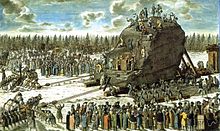Marinos Charvouris
Marinos Charvouris (actually: Count Marin Carburi de Cefalonie, called Count von Lascaris Μαρίνος Χαρβούρης, * 1729 in Argostoli ; † April 19, 1782 in Lixouri ) was an engineer from Kefalonia. He became famous for transporting a large rock over a distance of 22 km, which serves as the base of a monument to Peter the Great .
biography
Charvouris was born in Argostoli on Kefalonia and studied at the University of Bologna . Contrary to what the family wanted, he did not study medicine or law, but instead enrolled as a mathematician and graduated as an engineer in Vienna. He then worked for the army of Austria-Hungary, but was poached by Catherine the Great, who used his compatriot Petros Melissinos as an intermediary . Charvouris became general of the tsarist army and commissioner for military buildings. He married Helena Chryssoskouleou, a Greek woman and daughter of the Russian Foreign Minister. After her death he left the country with their children, the ship sank on the crossing and he lost his 11-year-old son Giorgio. Together with his daughter Sophia, who was still alive, he settled in Paris, where his brother lived. There he wrote a book in 1777 with solutions to major transport problems. He got to know a French woman with whom he settled in Lixouri on his home island in 1779 and opened an estate with his colleague, the Frenchman Bandu, to research new methods of cultivating cotton. The estate made profits from cotton production and the cultivation of sugar cane. On April 19, 1782, the estate was ravaged by a band of robbers who had immigrated from Mani . They murdered Charvouris, Bandu, and all of the employees.
The foundation of the brazen rider
To erect a monument to Peter the Great , they wanted to bring a 1500 ton rock from Finland to St. Petersburg, if possible it should not be dismantled. For this purpose, Charbouris laid out a route over the 22 km long route and constructed a car body that was rolled on tree trunks. It was a logistical masterpiece, especially since the swamp area seemed very unsuitable. At first the granite block weighed 2,000 tons, but to give it a level base, Charvouris used a very violent charcoal fire that was fanned by two large forged bellows. The fire makes the surface of the granite blister. Simple blows with a hard object are enough to cut off a layer of the stone. This is how the stone got its smooth subsurface.
Up until then, it was the heaviest cargo that was ever moved. Overall, the planned transport from 1768 lasted from November 15, 1769 until the ceremonial conclusion on September 22, 1770. During the whole time there were neither accidents nor personal injuries. For a long time this was the largest stone ever moved and to this day it is the heaviest object moved by human power.
This act had been forgotten by 2003 when historians rediscovered this feat. The work of Charvouris was recognized in a traveling exhibition through Europe.
literature
- Εταιρεία Μελέτης Ελληνικής Ιστορίας: "Μαρίνος Χαρβούρης - Ο μεγαλοφυής Κεφαλλήν μηχανικός", Athens 2003
| personal data | |
|---|---|
| SURNAME | Charvouris, Marinos |
| BRIEF DESCRIPTION | Greek engineer |
| DATE OF BIRTH | 1729 |
| PLACE OF BIRTH | Argostoli |
| DATE OF DEATH | April 19, 1782 |
| Place of death | Lixouri |

